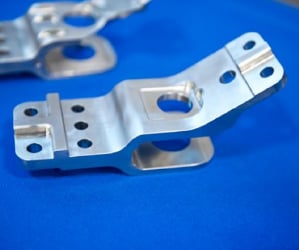Additive Manufacturing Is Reshaping Aviation
The aviation company Pratt & Whitney is exploring whether technology known as additive manufacturing could be used to develop more compact jet engines that could make commercial airplanes lighter and more fuel efficient.

Pratt & Whitney already uses two additive manufacturing techniques to make some engine components. Instead of casting metal in a mold, the methods involve forming solid objects by partially melting a metal powder with either a laser or an electron beam. Other aircraft makers use similar technology; GE, for example, creates fuel nozzles for jet engines using its own additive manufacturing techniques (see “Breakthrough Technologies 2013: Additive Manufacturing”).
The methods being used by GE and Pratt & Whitney are more complex and sophisticated than desktop 3-D printing, which involves creating objects by depositing ultrathin layers of material successively (see “The Difference Between Makers and Manufacturers”).
Additive manufacturing processes can reduce waste, speed up production, and enable designs that might not be feasible with conventional production processes. The novel shapes and unusual material properties the technology makes possible—such as propeller blades optimized for strength at one end and flexibility at the other—could change the way airplanes are designed.
One possibility being explored by Pratt & Whitney is engines with fewer parts, which would need less assembly and be cheaper to make. Frank Preli, chief engineer for materials and process engineering at the company, anticipates the possibility of radical new aircraft designs “like many engines embedded in a wing for ultra-aerodynamic efficiency.”
Such a design could have many benefits, says Mark Drela, a professor of aeronautics and astronautics at MIT. Distributing engines along the trailing edge of wings and in the rear of the fuselage can theoretically cut fuel consumption by 20 percent and decrease an aircraft’s weight. These benefits “add up to very large fuel burn reductions,” Drela says. Savings of 50 percent “are not inconceivable.”
To get to that point, Preli says, additive manufacturing techniques need to improve to allow for higher precision. Once researchers understand the fine, molecular-scale physics of how lasers and electron beams interact with powders, he says, “that will lead to the ability to put in finer and finer features, and faster and faster deposition rates.”
It makes sense that the aerospace industry has been among the first to adopt additive manufacturing—even slight improvements to performance or small reductions in weight can lead to big fuel savings, justifying the high initial cost of printing a part.
Keep Reading
Most Popular
Large language models can do jaw-dropping things. But nobody knows exactly why.
And that's a problem. Figuring it out is one of the biggest scientific puzzles of our time and a crucial step towards controlling more powerful future models.
How scientists traced a mysterious covid case back to six toilets
When wastewater surveillance turns into a hunt for a single infected individual, the ethics get tricky.
The problem with plug-in hybrids? Their drivers.
Plug-in hybrids are often sold as a transition to EVs, but new data from Europe shows we’re still underestimating the emissions they produce.
Stay connected
Get the latest updates from
MIT Technology Review
Discover special offers, top stories, upcoming events, and more.